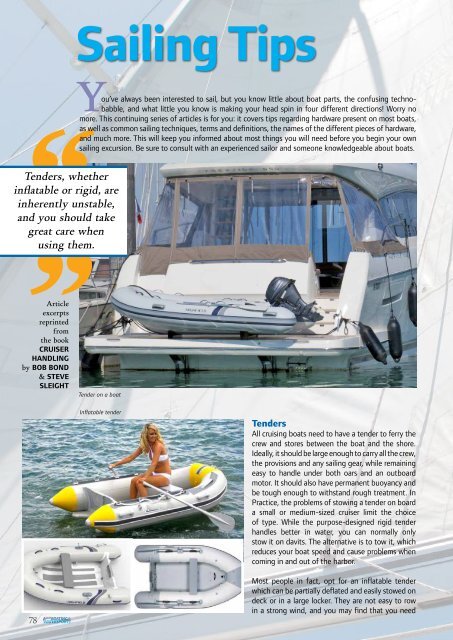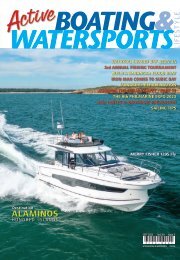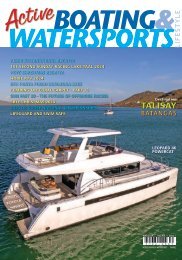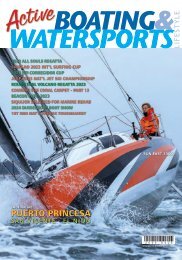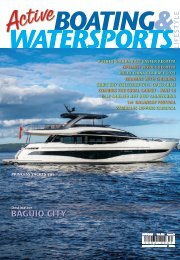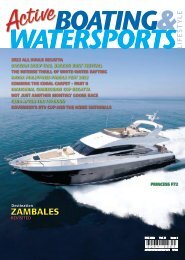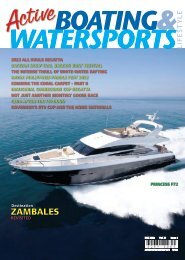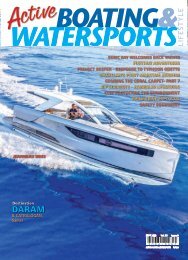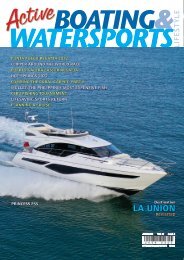You also want an ePaper? Increase the reach of your titles
YUMPU automatically turns print PDFs into web optimized ePapers that Google loves.
Sailing Tips<br />
Tenders<br />
Rowing a tender<br />
Motor tender<br />
You’ve always been interested to sail, but you know little about boat parts, the confusing technobabble,<br />
and what little you know is making your head spin in four different directions! Worry no<br />
more. This continuing series of articles is for you: it covers tips regarding hardware present on most boats,<br />
as well as common sailing techniques, terms and definitions, the names of the different pieces of hardware,<br />
and much more. This will keep you informed about most things you will need before you begin your own<br />
sailing excursion. Be sure to consult with an experienced sailor and someone knowledgeable about boats.<br />
Tenders, whether<br />
inflatable or rigid, are<br />
inherently unstable,<br />
and you should take<br />
great care when<br />
using them.<br />
Article<br />
excerpts<br />
reprinted<br />
from<br />
the book<br />
CRUISER<br />
HANDLING<br />
by BOB BOND<br />
& STEVE<br />
SLEIGHT<br />
78<br />
Tender on a boat<br />
Inflatable tender<br />
Tenders<br />
All cruising boats need to have a tender to ferry the<br />
crew and stores between the boat and the shore.<br />
Ideally, it should be large enough to carry all the crew,<br />
the provisions and any sailing gear, while remaining<br />
easy to handle under both oars and an outboard<br />
motor. It should also have permanent buoyancy and<br />
be tough enough to withstand rough treatment. In<br />
Practice, the problems of stowing a tender on board<br />
a small or medium-sized cruiser limit the choice<br />
of type. While the purpose-designed rigid tender<br />
handles better in water, you can normally only<br />
stow it on davits. The alternative is to tow it, which<br />
reduces your boat speed and cause problems when<br />
coming in and out of the harbor.<br />
Most people in fact, opt for an inflatable tender<br />
which can be partially deflated and easily stowed on<br />
deck or in a large locker. They are not easy to row<br />
in a strong wind, and you may find that you need<br />
an outboard motor for long trips. Inflatables, being<br />
soft, have the advantage that they don’t damage<br />
the boat when coming alongside.<br />
You should be very care when using the tender<br />
– more drowning’s result from misuse than from<br />
people going overboard from a cruiser. Make sure<br />
that crew members wear a lifejacket in the tender,<br />
even on short trips, and even if they can swim. Never<br />
overload the tender – make two trips if necessary.<br />
Towing a Tender<br />
If you have a rigid tender you will probably have to<br />
tow it behind your boat, at least for short trips. Even<br />
if you have an inflatable you may prefer to tow it<br />
occasionally rather than deflate it and stow it. If you<br />
know you are going to use it again shortly. Before<br />
setting off, remove all loose gear from the tender<br />
and stow it aboard the boat. Use a strong warp as<br />
a towing line, making sure that it is long enough<br />
to allow the tender to lie well astern of the boat.<br />
The line should be fixed to a through-bolted eye<br />
on the outside stem of the dinghy. A slack reserve<br />
line should be fastened from the tender to the boat<br />
just in case the towing line breaks. In strong winds<br />
you may find that an inflatable tender becomes<br />
airborne or even blows ahead of the boat. Under<br />
these conditions, shorten the towing line. You may<br />
also need a shorter line when towing a tender in the<br />
harbor. A rigid tender is, in fact, more difficult to<br />
tow than an inflatable. It sometimes tends to surf<br />
down a wave when the boat is sailing off-wind,<br />
and crash into the boat. In this case, you should<br />
lengthen the line even though the tender mat sheer<br />
about as a result.<br />
If you are maneuvering in congested waters, a crew<br />
member should look after the tender to ensure that<br />
the towing line doesn’t foul the propeller or rudder,<br />
and that the tender does not hit any other boats.<br />
Never try to board the tender when under way, for<br />
whatever reason.<br />
Using a Tender<br />
Tenders, whether inflatable or rigid, are inherently<br />
unstable, and you should take great care when using<br />
them. Be particularly careful getting in and out of<br />
the tender to avoid upsetting it. After launching it<br />
in the water, secure the painter to a stanchion base<br />
or deck cleat near the shrouds.<br />
The oarsman should get in first, stepping into the<br />
middle of it, and sitting down immediately on the<br />
central thwart, facing the stern. The oars are passed<br />
to him, followed by any stores being transported.<br />
Make sure the weight is distributed evenly. Any<br />
other passengers should then get in, taking care to<br />
balance the tender, and holding it steady against the<br />
sides of the cruiser. When the oarsman has fitted<br />
the outboard oard into its rowlock, and said he is<br />
ready, the crew member nearest the painter casts<br />
off and pushes the tender clear so that the oarsman<br />
can fit the other rowlock and oar.<br />
To disembark, simply reverse the order of getting in,<br />
taking care to keep the weight balanced. If you are<br />
coming ashore in tidal water, make sure your dinghy<br />
is pulled up above the high water mark if there is<br />
an incoming tide. If coming ashore in an unfamiliar<br />
estuary or river, watch out for deep mud. Use the<br />
slip way is there is one.<br />
Rowing a Tender<br />
Rowing a loaded tender is hard work, and the<br />
oarsman must therefore be competent. If the<br />
waters are tidal, work out your<br />
plan of approach to your boat<br />
or to the shore, depending on<br />
the direction and strength of the<br />
current. Remember that it is always<br />
strongest at the point mid-way<br />
between high and low tide. It is<br />
also worth remembering that the<br />
current is usually weaker in shallow<br />
water.<br />
Foot pump<br />
79


